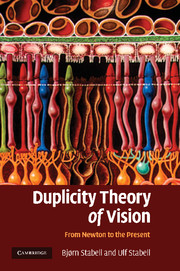Book contents
- Frontmatter
- Contents
- Acknowledgements
- 1 Introduction
- Part I The development of the basic ideas of the duplicity theory from Newton to G. E. Müller
- Part II The development of the duplicity theory from 1930–1966
- Part III Chromatic rod vision: a historical account
- Part IV Theories of sensitivity regulation of the rod and cone systems: a historical account
- 15 Introduction
- 16 Early photochemical explanations
- 17 Contribution of S. Hecht
- 18 Contribution of G. Wald: photochemical sensitivity regulation mechanisms of rods and cones
- 19 Relationship between amount of rhodopsin and sensitivity during dark adaptation
- 20 Post-receptor sensitivity regulation mechanisms
- 21 Rushton's AGC model
- 22 Contribution of H.B. Barlow
- 23 Rushton and Barlow compared
- 24 The Dowling-Rushton equation refuted
- 25 Several mechanisms involved in sensitivity regulation
- 26 Sensitivity regulation due to rod-cone interaction
- 27 Modern conceptions of sensitivity regulation
- Part V Factors that triggered the paradigm shifts in the development of the duplicity theory
- References
- Index
25 - Several mechanisms involved in sensitivity regulation
Published online by Cambridge University Press: 22 January 2010
- Frontmatter
- Contents
- Acknowledgements
- 1 Introduction
- Part I The development of the basic ideas of the duplicity theory from Newton to G. E. Müller
- Part II The development of the duplicity theory from 1930–1966
- Part III Chromatic rod vision: a historical account
- Part IV Theories of sensitivity regulation of the rod and cone systems: a historical account
- 15 Introduction
- 16 Early photochemical explanations
- 17 Contribution of S. Hecht
- 18 Contribution of G. Wald: photochemical sensitivity regulation mechanisms of rods and cones
- 19 Relationship between amount of rhodopsin and sensitivity during dark adaptation
- 20 Post-receptor sensitivity regulation mechanisms
- 21 Rushton's AGC model
- 22 Contribution of H.B. Barlow
- 23 Rushton and Barlow compared
- 24 The Dowling-Rushton equation refuted
- 25 Several mechanisms involved in sensitivity regulation
- 26 Sensitivity regulation due to rod-cone interaction
- 27 Modern conceptions of sensitivity regulation
- Part V Factors that triggered the paradigm shifts in the development of the duplicity theory
- References
- Index
Summary
A breakthrough in our understanding of the underlying mechanisms of dark and light adaptation of rods and cones would, of course, have represented an important step forward in the development of the duplicity theory. Yet, due to the complexity of the task involved, the progress in our understanding has proceeded at a very slow pace. Indeed, no general agreement about basic sensitivity regulation mechanisms of rods and cones has yet been reached (see Cameron et al., 2006; Baehr et al., 2007).
In line with Parinaud's (1885) assumption that both light and dark adaptation were determined by a changes in the amount of rhodopsin in the rods, most of the leading research workers during the hundred years that followed tended to conceive of adaptation as controlled by photochemical processes in the outer segment of the receptors. Of course, the research workers knew that this presumption was an oversimplification. Thus, it had long been known that sensitivity regulation of the visual system could not be controlled by one single mechanism operating at one site only, but rather was the result of different mechanisms engaged at different sites in the visual pathway. Besides the obvious regulation of the incident photons by the variation of the pupil size (in humans the diameter of the pupil may vary from about 8 mm in scotopic to about 2 mm in photopic vision, reducing the light incident on the receptors by about 1.2 log units), evidence had been provided indicating that important light- and dark-adaptation mechanisms were located more centrally than the outer segment of the receptors (e.g. Kuffler, 1953 ; Lipetz, 1961 ; Rushton, 1965a, 1972 ; Barlow, 1972).
- Type
- Chapter
- Information
- Duplicity Theory of VisionFrom Newton to the Present, pp. 186 - 189Publisher: Cambridge University PressPrint publication year: 2009



